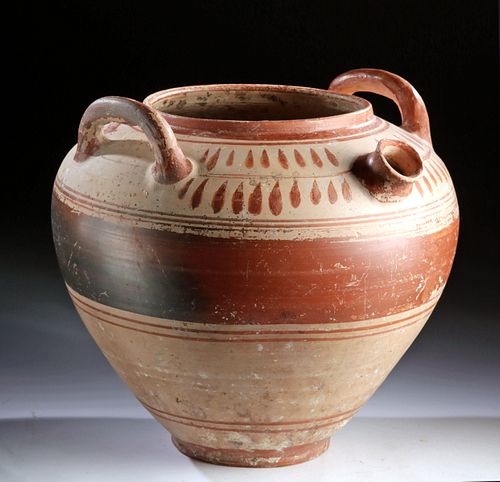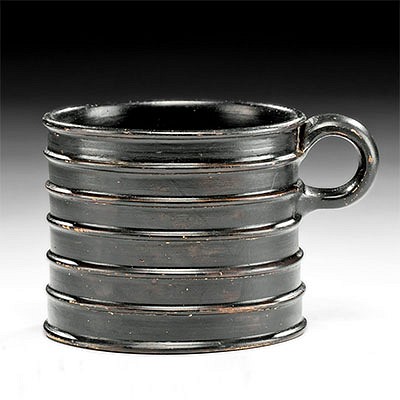Greek Messapian Bi-chrome Stamnos Strainer
Lot 24c
About Seller
Artemis Gallery
686 S Taylor Ave, Ste 106
Louisville, CO 80027
United States
Selling antiquities, ancient and ethnographic art online since 1993, Artemis Gallery specializes in Classical Antiquities (Egyptian, Greek, Roman, Near Eastern), Asian, Pre-Columbian, African / Tribal / Oceanographic art. Our extensive inventory includes pottery, stone, metal, wood, glass and textil...Read more
Categories
Estimate:
$2,600 - $3,900
Absentee vs Live bid
Two ways to bid:
- Leave a max absentee bid and the platform will bid on your behalf up to your maximum bid during the live auction.
- Bid live during the auction and your bids will be submitted real-time to the auctioneer.
Bid Increments
| Price | Bid Increment |
|---|---|
| $0 | $25 |
| $300 | $50 |
| $1,000 | $100 |
| $2,000 | $250 |
| $5,000 | $500 |
| $10,000 | $1,000 |
| $20,000 | $2,500 |
| $50,000 | $5,000 |
| $100,000 | $10,000 |
| $200,000 | $20,000 |
About Auction
By Artemis Gallery
Mar 12, 2020
Set Reminder
2020-03-12 10:00:00
2020-03-12 10:00:00
America/New_York
Bidsquare
Bidsquare : Ancient / Ethnographic Around The World
https://www.bidsquare.com/auctions/artemis-gallery/ancient-ethnographic-around-the-world-4957
Ancient art from Egypt, Greece, Italy and the Near East, as well as Asian, Fossils, Pre-Columbian, Native American, African / Tribal / Oceanic, Spanish Colonial, Russian Icons, Fine art, much more! Artemis Gallery info@artemisgallery.com
Ancient art from Egypt, Greece, Italy and the Near East, as well as Asian, Fossils, Pre-Columbian, Native American, African / Tribal / Oceanic, Spanish Colonial, Russian Icons, Fine art, much more! Artemis Gallery info@artemisgallery.com
- Lot Description
Magna Graecia, South Italic, Messapian, ca. 5th century BCE. An ample bi-chrome pottery vessel with a pronounced rim, inverted ample piriform body, disc foot, and twin upraised loop handles on the shoulder. Emerging from the front is a small spout with a perforated strainer. The vessel is beautifully decorated with a wide register of abstract leaves surrounding incised wheel marks that double as leaf veins on one side of the shoulder and a beautiful tendril of ivy leaves on the opposite side of the shoulder with wheel marks as well ( both in red on a cream ground). The remaining areas of the body are adorned with red striated bands of varying widths, and the handles and strainer/spout are a rich red to complement the cream. Size: 9.75" in diameter x 8.875" H (24.8 cm x 22.5 cm)
Although the Messapian people were influenced by Greek colonists in other parts of southern Italy, they had a distinctive culture that included burial practices uniquely their own. Unlike the Greeks in Apulia, Messapians reused their tombs for several burials, probably from the same family. Whenever a tomb was reused, the earlier grave goods were removed, along with the body, and then reburied inside or outside the same tomb. This beautiful stamnos strainer was most likely coveted for its design and functionality. Stamnoi were used to mix water and wine together, and the strainer on this piece made it possible to produce a purer liquid of the vine.
Provenance: private New York, New York, USA collection; ex-private H.G. collection, Rhineland-Palatinate, acquired in the 1970s to 1990s
All items legal to buy/sell under U.S. Statute covering cultural patrimony Code 2600, CHAPTER 14, and are guaranteed to be as described or your money back.
A Certificate of Authenticity will accompany all winning bids.
We ship worldwide and handle all shipping in-house for your convenience.
#147021Chips to handles and spout. Repairs and restoration to one handle and spout. Repair to wall beneath the spout. Expected surface wear with scuffs/scratches/abrasions and some loss to pigmentation but much remains. Surface deposits on exterior as well as interior and areas of encrustation as shown.Condition
- Shipping Info
-
All shipping is handled in-house for your convenience. Your invoice from Artemis Gallery will include shipping calculation instructions. If in doubt, please inquire BEFORE bidding for estimated shipping costs for individual items.
-
- Buyer's Premium



 EUR
EUR CAD
CAD AUD
AUD GBP
GBP MXN
MXN HKD
HKD CNY
CNY MYR
MYR SEK
SEK SGD
SGD CHF
CHF THB
THB
















